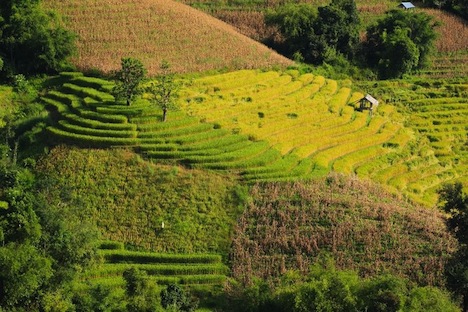The outcome of the parliamentary elections in Thailand’s February 2 vote is almost certain, with the opposition Phak Prachathipat (Democrat Party, พรรคประชาธิปัตย์) boycotting the election, thereby handing an artificially inflated landslide victory![]() to prime minister Yingluck Shinawatra and her allies.
to prime minister Yingluck Shinawatra and her allies.
Anti-government protests, which began in November over a proposed amnesty bill, and which resulted in Yingluck’s decision in December to call snap elections, continue to rage on, and Yingluck’s government, having already called a state of emergency, has indicated it will start cleaning government buildings in Bangkok of occupying protesters on Monday, February 3.
Though the protests have long eclipsed their immediate cause, an amnesty bill that both Yingluck’s supporters and opponents jeered, the ensuing ignition of political tension (and political violence) between the pro-government ‘red shirts’ and the opposition ‘yellow shirts’ has threatened to endanger the fragile stability that Yingluck, the sister of former, now exiled, prime minister Thaksin Shinwatra, tried to establish since her initial election in 2011.
But lurking behind the protests and the tension is a parallel controversy over the most consequential policy decision of Yingluck’s government — a well-intentioned rice subsidy scheme designed to stabilize the price of the rice crop for Thai farmers not only ran out of money, leaving farmers dissatisfied and angry, but knocked Thailand from its perch as the world’s top rice exporter and now threatens to plunge Thai’s credit rating to junk status.
Even if Yingluck makes it through the elections, and even if Yingluck and her opponents reach a deal on fresh elections in which the Democrats participate later this year, she now faces an impeachment inquiry over the rice subsidy scheme from the from the country’s National Anti-Corruption Commission, an independent body. That means that Yingluck’s ‘yellow shirt’ opponents will have a valid basis for the foreseeable future to undermine her leadership.
The rice scheme is essentially a case study in failed economic policymaking. When Yingluck came to power after the July 2011 parliamentary elections, she tried to implement a scheme to guarantee the price of rice at around $500 per ton, up to 50% higher than the prevailing market rate at the time. Though the idea was to stabilize the incomes of millions of relatively poor rice farmers that comprise a key segment of the political base for Yingluck and her ruling Pheu Thai Party (PTP, ‘For Thais’ Party, พรรคเพื่อไทย).
For decades, the Thai government incentivized rice production by investing in projects with large fixed costs, such as irrigation, infrastructure and other financing programs. Rice production, traditionally based in central Thailand, expanded into northeastern Thailand, nearly doubling the amount of land for rice cultivation between the 1950s and the 1980s — and made Thailand the world’s top rice exporter. That growth hasn’t always trickled down to low-income farmers, however, as greater competition forced one-time landowners to become tenant farmers as larger operations scaled upward.
But the scheme quickly turned into a disaster. Starting in October 2011, the government started buying rice at artificially high prices, causing the domestic price to rise. That caused a substantial drop in Thai rice production and a rise in the cost of Thai rice on global markets. Thai rice exports dropped by 35%, allowing India and Vietnam to export more rice than Thailand for the first time — in 2013, Thailand was expected to export just 6.5 tons of rice, compared to Vietnam’s 7.4 tons and Indian’s 9 tons.
What’s more, it left the Thai government holding a stockpile of 17 million tons of rice that it purchased at inflated rates. The cost of the rice scheme quickly exceeded its 500 billion baht ($15 billion) budget by around 200 billion baht ($6 billion), much of it due to corruption and inefficiency. That comes on top of a plan by Yingluck’s government to make $66 billion in additional infrastructure investments by 2020, mostly for a high-speed rail network to connect Thailand’s four regions to Bangkok, in tandem with a Chinese plan to link Kunming, the capital of Yunnan province in southwest China, by rail to Singapore, through northeastern Thailand, Bangkok and the Laotian capital of Vientiane. The rice scheme hasn’t encouraged foreign investors that Thailand’s government is up to the task. Moreover, Thailand’s budget for 2013 is 2.4 trillion baht ($77 billion), so the rice scheme comprises a significant component of government spending, crowding out funds that could be more smartly allocated to infrastructure.
The government eventually quickly that the scheme is untenable, it attempted to cut the subsidized price by 20% last year. But rice farmers thwarted the government’s plan, leaving Yingluck between a political rock and a financial hard place, with her government having promised a political entitlement to farmers that it cannot responsibly deliver over the long term. Many farmers still haven’t been paid because the Thai government ran out of funds to pay them and didn’t allocate any new budget funds before the most recent political crisis. That, theoretically, could have endangered Yingluck in the February elections, had the opposition bothered to run an electoral campaign.
The government is now forced to seek up to 140 billion baht ($4.3 billion) in financing to cover the cost overrun, and that alone could endanger the country’s credit rating. Moody’s ranks Thai debt at Baa1 and Standard and Poor’s ranks it at BBB+ (its equivalent to Baa1), but that’s just two notches above non-investment grade — i.e., junk bond status. If Thailand’s political crisis deepens, it’s not hard to imagine that ratings agencies with downgrade their outlook, causing borrowing costs to rise rapidly.
Photo credit to bplanet / 123RF Stock Photo.
